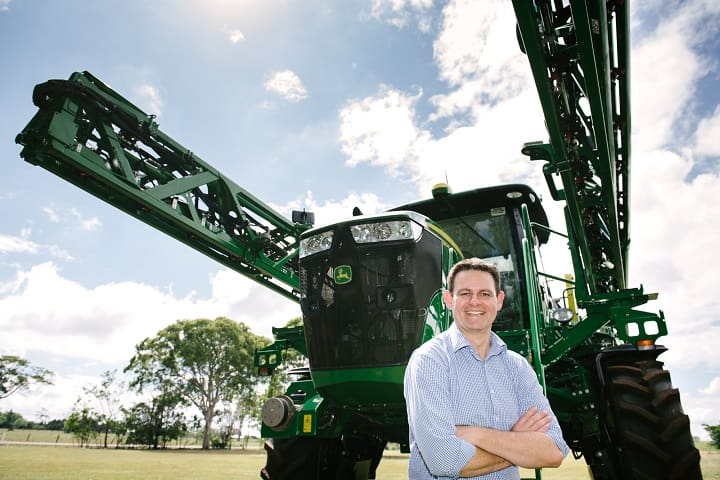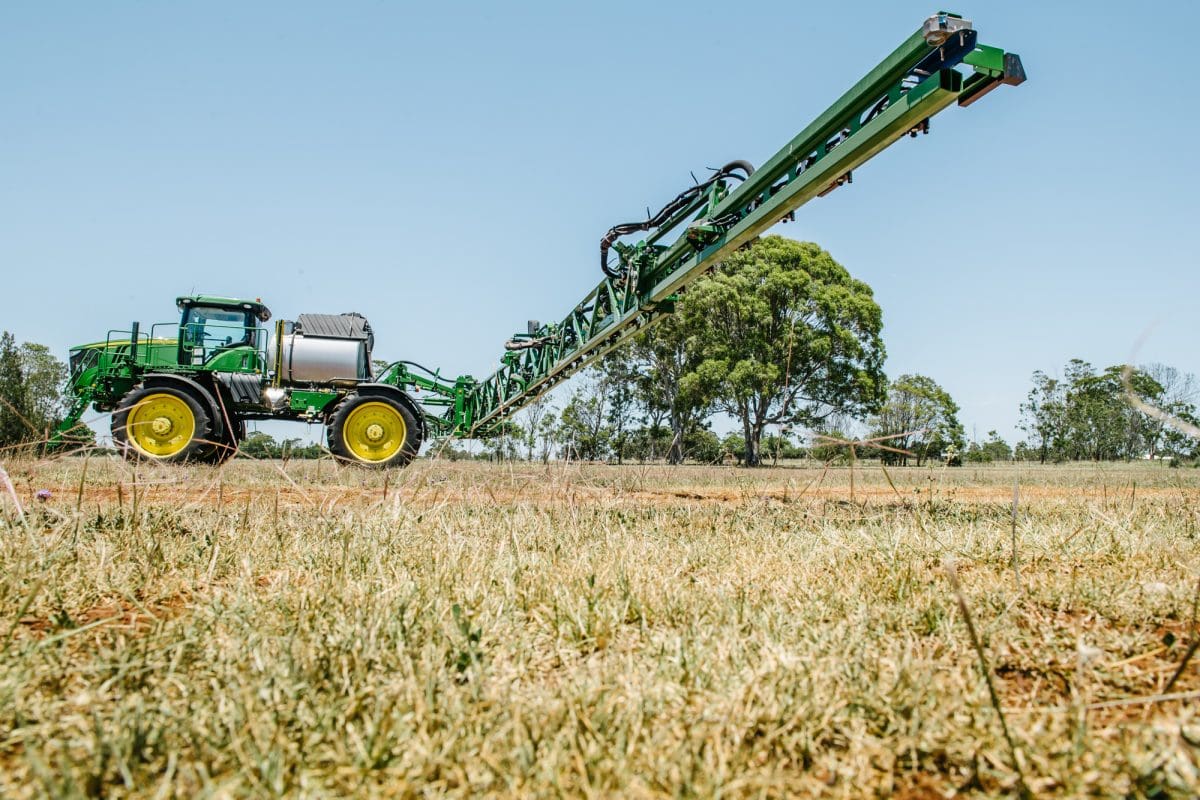
University of Southern Queensland (USQ) Centre for Agricultural Engineering (CAE) director, Professor Craig Baillie.
THE adoption of cutting edge, advanced technologies in agriculture to date has been underwhelming and can only be progressed if the latest innovations present real value to a farmer and can be monetised by developers to realise a commercial return.
That was one of the findings University of Southern Queensland (USQ) Centre for Agricultural Engineering (CAE) director, Professor Craig Baillie, gleaned from a 2019 Fulbright Scholar Award that saw him spend four months at College Station, Texas, in the United States from November last year, working with Texas A&M University and other research institutions.
Professor Baillie said the focus of his scholarship, which was awarded through the Australian-American Fulbright Commission, was to look at game-changing technologies that would influence agriculture.
“What I really tried to understand was the massive investment that has gone into ag technology in the last six to seven years, what has been fuelling that, has it made an impact, and how well does it actually perform in relation to some of the global narratives that say we need to increase production by 50 per cent in the next 30 years if we are going to meet the growing demands of population growth,” he said.
“There is a large investment, particularly in the United States, that is fuelling the concept that we need to feed the world, and therefore ag technologies are the way to do that.
“But what you see is that where that investment is being made, technologies have to monetise that. There are top-down drivers, which are the global narratives, and there are bottom-up-drivers which are ‘What does a farmer actually need?’.
“You see lots of situations where that large amount of money is pivoting to try to monetise the investment. Where there has been massive investment by a lot of those companies, they are struggling to try to monetise the technology.”
Productivity gains
Professor Baillie said while the uptake of new technologies had the potential to create the most dramatic lifts in production in Third World countries, there was the potential to achieve modest, but still worthwhile gains in advanced agricultural countries like Australia.
“We see in areas like Africa that the yield gap is as much as 70 per cent. So, in terms of what you could theoretically produce versus what they actually produce, the yield gap is about 70pc which is huge. But those areas are not likely to be able to adopt the technologies that are being developed,” he said.
“In other areas, the US in particular, where some of the farming systems are highly tuned, there is probably only 10 to 15 per cent improvement you could make.
“Also in Australia, even though our grain industry is fairly sophisticated, there are large opportunities when you look at the potential versus what is actually realised. But again, it (ag tech) is not going to make up that difference.”
However, Professor Baillie said even the potential for new technologies to make up some of the difference was worth considering by Australian farmers.
“When ABARES looked at what is driving the most profitable farms, some of the work found it is really about the scale of the operation that tends to lead to a more profitable and productive operation. But, when they started to analyse that, they could only explain a small proportion of that being due to scales of economy,” he said.
“So, just because you are bigger doesn’t account for that difference in yield, productivity and profitability. There has to be something else going on. They suggest the difference is because of different farming practices and technology adoption.”
“Autonomous systems are the next big thing. This is where technologies are heading as we drive towards greater efficiency and more precision on-farm.” – Craig Baillie
Australia as innovation incubator
Professor Baillie said one of the aims of his trip to the US was to establish a network of research and development connections between Australia and the US.
He said Australian farmers operated in a highly volatile environment compared to the US and were at the leading edge of innovative technologies because they had to compete, but Australia didn’t have the mass market to sustain the commercial development of new technologies.
“If we look at the American scene, the American farmer is very similar to our farmers, but not quite as tuned to needing that technology early because they don’t have the same volatility,” he said.
“So, if we can connect the US and Australian scene a lot better where Australia is seen as more the incubator of technologies for a mass market in the US, the Australian farmer gets access to that technology sooner.
“The carrot for the OEMs (Original Equipment Manufacturers) and large manufacturers is that the technology that gets developed here is ready for the overseas markets where they can exploit the commercial value.
“You need a mass market to commercialise those technologies, so innovation and development we do in Australia has to have a global reach. Without that global reach you can’t sustain the commercialisation of those technologies.”
Australia-US network
Professor Baillie said it was important for the CAE and other Australian entities working on precision technologies to look beyond the research phase and move to commercialise technologies through the networks created between Australia and the US.
“There is large investment in technologies in the US. The narrative around that is to increase productive output to meet world population needs,” he said.
“What you see is that when those technologies have been commercialised they need to be monetised. To monetise them, you need to work out what the value proposition is for the farmer to be able to purchase those technologies and use them on-farm.
“So, we see an interplay between developing a piece of technology to tackle a global need versus the reality of producing a technology that is going to be of benefit to a farmer who needs to be profitable to stay in business. That is an interesting dynamic.”
Professor Baillie said it was important to look at the pathways to adoption of the technology on farms.
“Sometimes that involves working with large manufacturers like John Deere, in other cases we might be licensing technology to consultants and agronomists,” he said.
Future in precision
Professor Baillie said it was clear that the future of agriculture was about doing things more precisely to increase the value of each farming activity.
“That is where automation and robotics come into it. Sooner or later you will get to a point where you can’t exploit the potential because you can’t operate with the precision you need. Automation and robotics is able to extract that level of precision. The focus of the future will be around automated systems,” he said.
“Autonomous systems are the next big thing. This is where technologies are heading as we drive towards greater efficiency and more precision on-farm. We get to a point where the level you can execute that sort of precision needs some sort of autonomous system.
“Autonomy is about executing a higher level of precision in the field to be able to get the right thing in the right place at the right time. It can relate to the spatial application of fertilisers on a farm or spot-spraying weeds within a crop. In a cropping sense, we are moving from zonal management of a field down to individual plants.”

“We are moving from zonal management of a field down to individual plants.” – Craig Baillie
Space age developments
The CAE has been in discussions with the US’s National Aeronautics and Space Administration (NASA) about the CAE’s research into field sensors and machine vision that has improved the understanding of how crops perform relative to how much irrigation is applied.
“Those concepts translate to space agriculture. As NASA is looking to go out to Mars which is a three-year journey, they can’t take the food with them, so they need to be able to grow it in space,” Professor Baillie said.
“So, there is a real opportunity to translate some of the things we have done into a different environment altogether.
“We are having a conversation with NASA at the moment about how we translate some of the things we have done around individual plant management and crop response to be able to be used.”
Grain Central: Get our free daily cropping news straight to your inbox – Click here



HAVE YOUR SAY